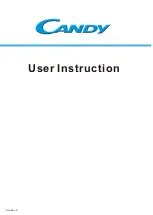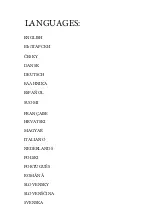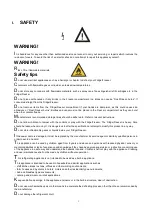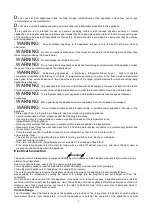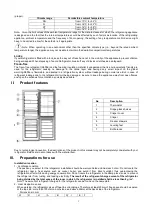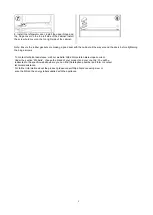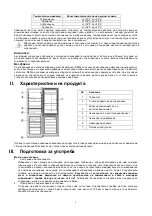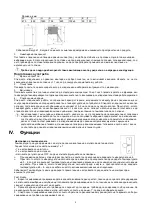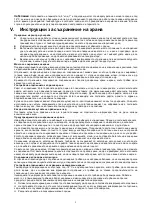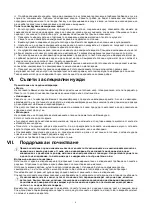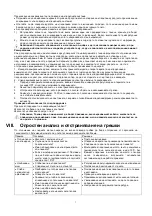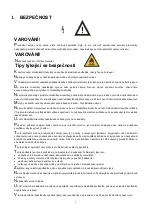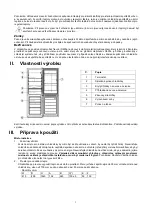
6
steam cooked. Frozen sauces and soups can be put into a saucepan and heated gently until thawed.
8.Use quality food and handle it as little as possible. When foods are frozen in small quantities, it will take less than for
them to freeze up and thaw.
9.Estimate the amount of foods to be frozen up. When freezing large amounts of fresh food, adjust the temperature
control knob to the low mode, with the freezer temperature lowered. So, foods can be frozen up in fast manner, with the
food freshness well kept.
VI.
Tips for special needs
Moving the refrigerator/freezer
•
Location
Do not place your refrigerator/freezer near a heat source, e.g. cooker, boiler or radiator. Avoid it from direct sunlight in
out-buildings or sun lounges.
•
Leveling
Make sure to level your refrigerator/freezer using the front leveling feet. If not level, the refrigerator/freezer door gasket
sealing performance will be affected, or even it may lead to the operating failure of your refrigerator/freezer.
After locating the refrigerator/freezer in position, wait for 4 hours before using it, so as to allow the refrigerant to settle.
•
Installation
Do not cover or block the vents or grilles of your appliance.
When you are out for a long time
•
If the appliance will not be used for several months, turn it off first, and then unplug the plug from the wall outlet.
•
Take out all foods.
•
Clean and dry the interior thoroughly. To prevent odor and mold growth, leave the door ajar: block it open or have the
door removed if necessary.
•
Keep the cleaned appliance in a dry, ventilated place and away from the heat source, place the appliance smoothly, and
do not place heavy objects on top of it.
•
The unit should not be accessible to child’s play.
VII.
Maintenance and cleaning
Before cleaning, unplug the power plug first; Do not plug in or plug out the plug with wet hand, because
there is a risk of electric shock and injury. Do not spill water directly on the refrigerator, to avoid rust, electricity
leakage and accidents. Do not stretch your hands into the bottom of the refrigerator, since you might be
scratched by sharp metal corners.
Internal cleaning and external cleaning
The food residuals in the refrigerator are liable to produce bad odor, so the refrigerator must be cleaned regularly. The
fresh food compartment is usually cleaned once a month.
Remove all shelves, crisper box, bottle racks, cover board, and drawers etc., and clean them with a soft towel or sponge
dipped in warm water or neutral detergent.
Clear off the dusts accumulated on the rear panel and side plates of the refrigerator often.
After using detergent, be sure to rinse it with clean water, and then wipe it dry.
Do not use bristle brush, steel wire brush, detergent, soap powder, alkaline detergent, benzene, gasoline,
acid, hot water and other corrosive or soluble items to cleanse the cabinet surface, door gasket, plastic
decorative parts, etc., so as to avoid damage.
Carefully wipe dry the door gasket, clean the groove using a wooden chopstick wrapped with cotton string. After the
cleaning, fix the four corners of the door gasket first, and then embed it segment by segment into the door groove.
Interruption of power supply or failure of the refrigerating system
•
Take care of the frozen foods in the event of an extended non-running of the refrigerating appliance (such as interruption
of power supply or failure of the refrigerating system).
•
Try to open the refrigerator door as less as possible, in this way can food safely and freshly kept for hours even in hot
summer.
•
If you get the power outage notice in advance
:
1)
Adjust the thermostat knob to the high mode an hour in advance, so that foods get fully frozen (Do not store new
food during this time!). Restore the temperature mode to the original setting when power supply becomes normal in a
timely manner.
2)
You can also make ice with a watertight container, and put it in the upper part of the freezer, so as to extend the time
for fresh food to be stored.
Note: Once the refrigerator is used, you’d better use it continuously; and under normal circumstance, do not
stop its use, so as not to affect the service life.
Defrosting
After a period of use, a thin layer of frost will be formed on the freezer compartment inner wall (or evaporator) surface,
which may affect the refrigeration effect if exceeding 5mm in thickness. In such case, you need to gently scrape the frost
off using an ice scraper rather than the metal or sharp hardware. Frosts need to be cleared off every 3 months or so, and if
Summary of Contents for CCG1L314ES
Page 1: ... Revision C ...

